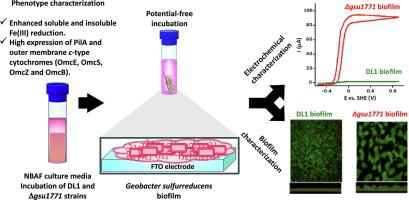Bioelectrochemistry ( IF 5 ) Pub Date : 2022-03-21 , DOI: 10.1016/j.bioelechem.2022.108101 Alberto Hernández-Eligio 1 , Guillermo Antonio Huerta-Miranda 2 , Sergio Martínez-Bahena 3 , Dulce Castrejón-López 3 , Margarita Miranda-Hernández 2 , Katy Juárez 3

|
Type IV pili and the >100c-type cytochromes in Geobacter sulfurreducens are essential for extracellular electron transfer (EET) towards metal oxides and electrodes. A previous report about a mutation in the gsu1771 gene indicated an enhanced reduction of insoluble Fe(III) oxides coupled with increased pilA expression. Herein, a marker-free gsu1771-deficient mutant was constructed and characterized to assess the role of this regulator in EET and the formation of electroactive biofilms. Deleting this gene delayed microbial growth in the acetate/fumarate media (electron donor and acceptor, respectively). However, this mutant reduced soluble and insoluble Fe(III) oxides more efficiently. Heme staining, western blot, and RT-qPCR analyses demonstrated that GSU1771 regulates the transcription of several genes (including pilA) and many c-type cytochromes involved in EET, suggesting the broad regulatory role of this protein. DNA-protein binding assays indicated that GSU1771 directly regulates the transcription of pilA, omcE, omcS, and omcZ. Additionally, gsu1771-deficient mutant biofilms are thicker than wild-type strains. Electrochemical studies revealed that the current produced by this biofilm was markedly higher than the wild-type strains (approximately 100-fold). Thus, demonstrating the role of GSU1771 in the EET pathway and establishing a methodology to develop highly electroactive G. sulfurreducens mutants.
中文翻译:

GSU1771 调节硫还原杆菌的细胞外电子转移和电活性生物膜形成:遗传和电化学表征,GSU1771 调节硫还原杆菌的细胞外电子转移和电活性生物膜形成:遗传和电化学表征
还原地杆菌中的 IV 型菌毛和 >100 c型细胞色素对于向金属氧化物和电极的细胞外电子转移 (EET) 至关重要。先前关于gsu1771基因突变的报告表明不溶性 Fe(III) 氧化物的减少以及pilA表达增加。在此,无标记的gsu1771构建和表征-缺陷突变体以评估该调节剂在EET中的作用和电活性生物膜的形成。删除该基因会延迟醋酸盐/富马酸盐培养基(分别为电子供体和受体)中的微生物生长。然而,这种突变体更有效地减少了可溶性和不溶性 Fe(III) 氧化物。血红素染色、蛋白质印迹和 RT-qPCR 分析表明 GSU1771 调节 EET 中涉及的几个基因(包括pilA)和许多c型细胞色素的转录,表明该蛋白质具有广泛的调节作用。DNA-蛋白质结合分析表明 GSU1771 直接调节pilA、omcE、omcS和omcZ的转录. 此外,gsu1771 缺陷突变生物膜比野生型菌株厚。电化学研究表明,这种生物膜产生的电流明显高于野生型菌株(约 100 倍)。因此,证明了 GSU1771 在 EET 途径中的作用,并建立了一种方法来开发高电活性的G.sulfurreducens突变体。
,还原地杆菌中的 IV 型菌毛和 >100 c型细胞色素对于向金属氧化物和电极的细胞外电子转移 (EET) 至关重要。先前关于gsu1771基因突变的报告表明不溶性 Fe(III) 氧化物的减少以及pilA表达增加。在此,无标记的gsu1771构建和表征-缺陷突变体以评估该调节剂在EET中的作用和电活性生物膜的形成。删除该基因会延迟醋酸盐/富马酸盐培养基(分别为电子供体和受体)中的微生物生长。然而,这种突变体更有效地减少了可溶性和不溶性 Fe(III) 氧化物。血红素染色、蛋白质印迹和 RT-qPCR 分析表明 GSU1771 调节 EET 中涉及的几个基因(包括pilA)和许多c型细胞色素的转录,表明该蛋白质具有广泛的调节作用。DNA-蛋白质结合分析表明 GSU1771 直接调节pilA、omcE、omcS和omcZ的转录. 此外,gsu1771 缺陷突变生物膜比野生型菌株厚。电化学研究表明,这种生物膜产生的电流明显高于野生型菌株(约 100 倍)。因此,证明了 GSU1771 在 EET 途径中的作用,并建立了一种方法来开发高电活性的G.sulfurreducens突变体。



























 京公网安备 11010802027423号
京公网安备 11010802027423号